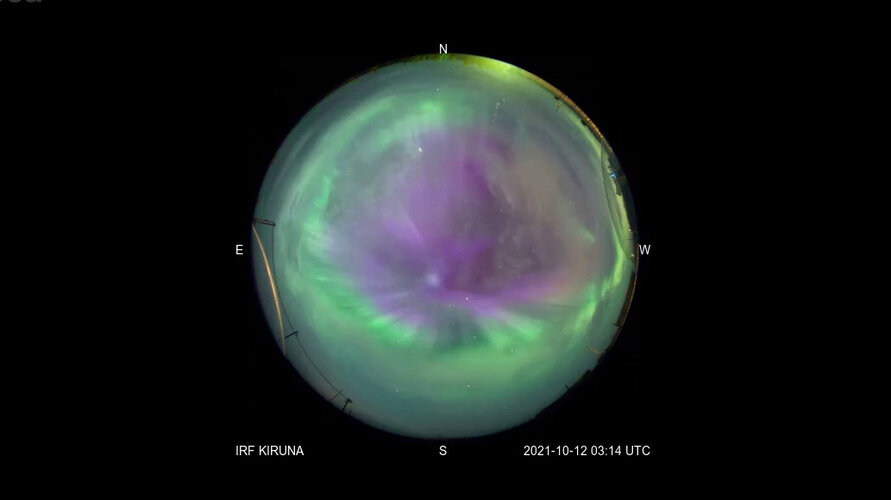
Video:
00:00:29
After the Sun ejected a violent mass of fast-moving plasma into space on 9 October, ESA waited for the storm to strike. A few days later, the coronal mass ejection (CME) arrived at Earth, crashing into our planet’s magnetosphere, and lighting up the sky.
CMEs explode from the Sun, rush through the Solar System and while doing so speed up the solar wind – a stream of charged particles continuously released from the Sun’s upper atmosphere.
While most of the solar wind is blocked by Earth’s protective magnetosphere, some charged particles become trapped in Earth’s magnetic field and flow down to the geomagnetic poles, colliding with the upper atmosphere to create the beautiful Aurora.
A marbled sky
This stunning video was created from images taken every minute during this recent period of intense auroral activity in the early hours of 12 October, by an all-sky camera in Kiruna, Sweden – part of ESA’s Space Weather Service Network. The goal of such cameras is to view as much as the sky as possible, so they are fitted with a ‘fish-eye’ lens to see horizon to horizon when pointed straight up.
The video, running in half-speed to accentuate the beautiful auroral motion, starts with a mass of green, swirling structures, created when energetic particles in the solar wind collide with oxygen in Earth’s atmosphere, which then, ‘excited’ gives off light in the green range of the electromagnetic spectrum. This typically occurs at around 120 – 180 kilometres from Earth’s surface.
As we humans have evolved to be very adept at seeing different shades of green, it’s the most predominant colour we see. Harder to see is the purple aurora seen later in the video, this time created as energetic particles strike ‘ionic’ nitrogen in Earth’s atmosphere.
Not just beautiful, such observations are vital to understanding the complex, and sometimes hazardous interactions between the Sun and Earth.
“What I love about this video is the chance to see this beautiful, purple aurora, more clearly visible during intense geomagnetic storms” explains Hannah Laurens, RHEA Space Weather Applications Scientist based at ESOC.
“The movement of this swirly structure in space and time is often referred to as auroral dynamics, and this is very important when studying the relationship between the ionosphere and magnetosphere, linked by lines of magnetic field. The aurora is a manifestation of complex drivers operating in the distant magnetosphere which makes it a useful, and beautiful, tool with which to monitor space weather conditions”.
A beautiful side of something more troubling
The all-sky auroral camera is operated by the Kiruna Atmospheric and Geophysical Observatory (KAGO) within the Swedish Institute of Space Physics (IRF), and data from here is provided as part of the ESA’s network of space weather services within the Agency’s Space Safety Programme.
This is the first auroral display captured by the instrument following its integration into the ESA Space Weather Portal, which provides timely information to anyone affected by the Sun’s outbursts – from airline pilots, to operators of spacecraft and power grids, or even hopeful aurora hunters.
While humans on Earth are protected by Earth’s magnetic field, Space Weather can have an extreme and disruptive impact on satellites in orbit and infrastructure on Earth, and ultimately our society. For this reason, ESA’s Space Weather Service Network continues to monitor our star and the conditions around Earth, to provide information to keep our systems safe.
In 2027, ESA will launch a first-of-its kind mission to monitor the Sun from a unique vantage point. Studying our star from the side, it will provide a stream of data that will warn of potentially hazardous regions before they roll into view from Earth.
Find out more about Space Weather, and sign up for free updates from ESA’s Space Weather Service Network.
Credit: All-sky camera, Kiruna Atmospheric and Geophysical Observatory (KAGO) within the Swedish Institute of Space Physics (IRF). Data provided as part of ESA’s Space Weather Service Network.
Click here for original story, Solar storm stirs stunning aurora
Source: ESA Space News